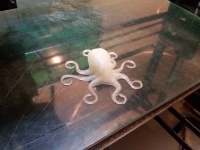3D Printing Primer
now that we have a live 3D-printer (known to work on both 110V and 220V), I think it would be interesting to have a workshop on 3D design software and 3D printing software.
Contents
Basics[edit]
In reply to someone who asked if a 3D printer is something like a normal printer... Here's a possible description of how a 3D printer basically works:
First off, you'll design a 3D-model. For this, you'll be using your favorite 3D program. This can be a 3D scanner, or something like Sketchup, Blender, OpenSCAD, FreeCAD, Autocad Inventor, etc... Here, you have all the properties and often you have the original shapes too.
The result of this process, is a native file for that environment. Next, you'll have to translate it to an intermediate format that turns the object into a shape. Typically STL is used for this. Originally, it's meant for stereolithography. Bottom line, it's a set of coordinates and how they connect.
Now comes the translation step that's pretty critical. If you want to compare it to regular printers, you could compare it with the really high end printers that had a seperate computer that translate an image into its best possible approximation within the possiblities of the printer. (RGB to CMYK conversion is a science on its own, and the chemicals called ink are yet another complete science). Back to the topic: converting your STL-file to a .gcode file is actually nothing more than converting the 3D object into sliced the thickness your printer can handle (or you decide it to become). There's also code in there for heating the plate, the nozzle, etc... but that's all taken care of by a seperate program.
Once you created that .gcode file, you'll need an extra piece of software to send the .gcode directly to the printer. Often this software will also offer some features to manually control the 3D-printer (f.e. to clean the nozzle)
The printer is connected by a USB-port. That's as plain as it gets. I have no idea how much "plug and play" there is in Windows or Mac. Under Linux, it's all manual installable, but it pretty much works out of the box. Understanding how you can optimize your settings is how you can recognize the true master. :)
A possible workflow/toolkit[edit]
- Design your model in FreeCAD or OpenSCAD. Here, you can export the file to STL.
- In Slic3r, you'll be entering the settings of your 3D-printer, and loading the part(s) you want to print in one run. Now you can save the file to .gcode.
- Now, the last step, you could use Pronterface (Printrun) to send the .gcode file to the printer and monitor the progress.
- Unless your piece is really tiny, now is a good time to get yourself a Club Mate (and maybe have some lunch, and if it's really big... get your sleeping bag)
3D design software[edit]
- OpenSCAD - let's have a shot at the basics and code some little thingie
- FreeCAD - let's create a Raspberry Pi case (yeah, I know, soooo creative) --> Ctrl-S is the good reflex, it tends to crash every so often...
Next, we can try designing a case for The black knight doorscanner - each takes weapon of choice...
3D printing software[edit]
The result of your 3D design, will describe the properties of a model, like coördinates of every point (f.e. an STL-file). As a 3D printer won't follow these shapes up and down along with the design, but print layer per layer, we'll be needing a different type of file. You could compare it with a regular printer that prints a photo. This also won't first draw the head and then the eyes...it will print line per line. Your 3D printer typically needs a file telling it how to draw each layer. It also includes some technicalities (f.e. how to fill the insides of a shape, and how much the nozzle must heat up). This file is called a gcode-file, and depends of 3 aspects: the printer, the used material and the design/quality.
The following software will help you turn your cleverly designed 3D image into a tangible piece of plastic...
- Slic3r: translate a source file (f.e. STL) into a gcode file that tells the 3D printer how to print.
- Printrun: basically the dashboard of your 3D printer - here you can control your printer, or send commands to it (like: "print awesomedesign.cgode")
Downloads[edit]
Both the Lulzbot TAZ3 manual and the needed software can be downloaded from the Lulzbot site (http://www.lulzbot.com/support/downloads)or from the respective homepages. for both GNU Linux, Mac OS X or Windows... or you could compile from source.
I'd like to give a big thumbs up for the Lulzbot manual. It describes the steps on how to control the printer very much in detail. Especially how to use Slic3r and Printrun are explained quite in depth. I printed this one and have it at home for reference!
Documentation and links[edit]
Basics[edit]
3D design software[edit]
- Blender pour l'impression 3D (Merci Serge!)
- 3D model of Raspberry Pi ... handy for fitting inside your design.
